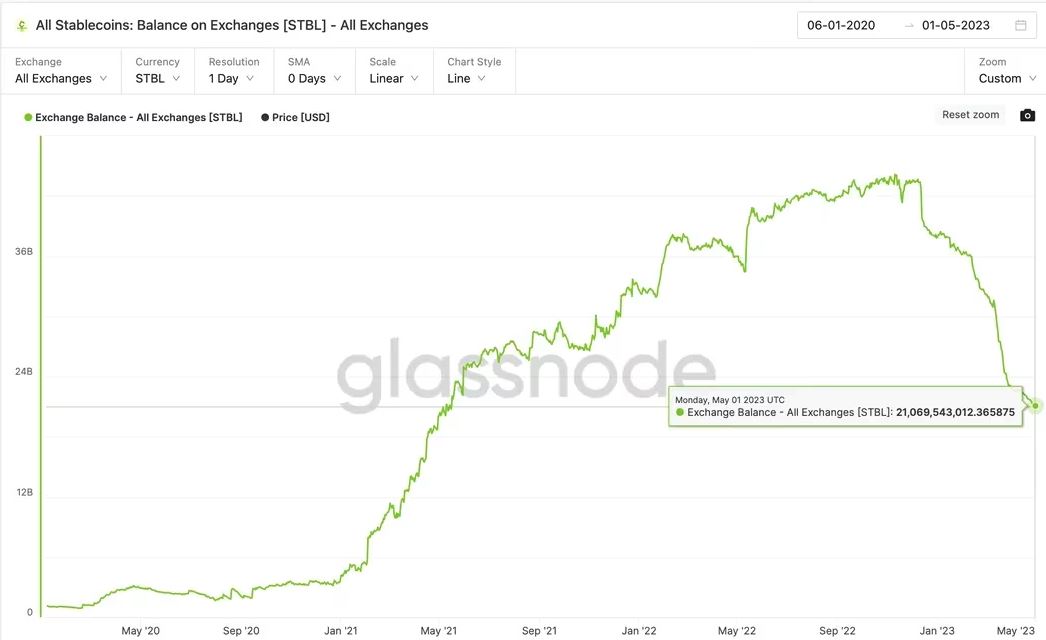
Despite the decline in stablecoin balances, Tether (USDT), the world’s largest stablecoin by market value, has gained more dominance in the market.
- Stablecoin balances on centralized exchanges have reached their lowest point since May 2021.
- Recent market movements and external factors have ripple effects throughout the sector.
- Regulatory scrutiny and instability in the stablecoin market have rattled confidence.
Ever since the rise in regulatory crackdowns and the de-pegging of major players like BUSD and USDC, the stablecoin markets have been rattled, even undergoing a decline in total market cap.
As of Monday, the balance stood at just $21.06 billion, according to data from Glassnode. The blockchain analytics firm revealed that the effects have been far-reaching, and even prominent stablecoins such as BUSD, USDT, and USDC have not gone untouched.
Stablecoins Plunge as Bitcoin Soars: Coincidence?
The decline in stablecoin balances on centralized exchanges has been accompanied by a decreased stablecoin market cap. This coincides with Bitcoin’s 70% rally this year, suggesting that funds have moved from stablecoins to BTC. Nevertheless, the market has yet to see any new money inflows.
Sponsored
Investors have increasingly favored stablecoins for cryptocurrency purchases over the past three years as a means to bypass the price volatility associated with other tokens, but as their balances dwindle on centralized exchanges, investor caution appears to be on the rise.
Sponsored
Glassnode’s data reflects this, indicating that the volume of stablecoins held in centralized exchange addresses has dropped to its lowest level since May 2021.

This represents a decrease of more than half since reaching a peak of over $44 billion in mid-December. The decline gained momentum after U.S. regulators cracked down on Paxos’ BUSD in February and subsequent volatility in USDC in March.
Decline in Stablecoin Balances Linked to Regulation?
Dick Lo, the founder and CEO of quant-driven trading firm TDX Strategies, stated that the decline in stablecoin balances reflects investors’ reluctance to take risks after Paxos was ordered to stop issuing BUSD and the recent de-pegging of USDC.
This caused the market cap of BUSD and USDC to decline steadily. Paxos ceased issuing the centralized dollar-pegged stablecoin BUSD in February in compliance with a regulatory order from New York.
On the Flipside
- Despite the decline in stablecoin balances, Tether (USDT), the world’s largest stablecoin by market value, has gained more dominance in the market.
- The decrease in stablecoin balances on centralized exchanges indicates a potential shift towards decentralized exchanges.
- While stablecoins offer a way to bypass price volatility, they are not without their own risks, with a plethora of issuers struggling to reclaim lost pegs over the last year alone.
- Stablecoins have increasingly faced scrutiny for a perceived lack of transparency and regulatory compliance.
Why You Should Care
The decline in stablecoin balances held in centralized exchanges is significant for the broader crypto market because it reflects increasing investor aversion to risk. Stablecoins are commonly used to fund crypto purchases and bypass the price volatility of other tokens.
A dwindling balance coinciding with a Bitcoin price rise suggests a rotation of money out of stablecoins and into BTC, which has been a significant factor in driving the leading cryptocurrency’s rally so far this year.
To learn more about the latest attempt at stablecoin legislation by House Republicans, check out this article:
House Republicans’ Second Attempt at Stablecoin Legislation
If you want to stay up-to-date on the ongoing SEC lawsuit against Ripple and the possible verdict dates, this article has you covered:
